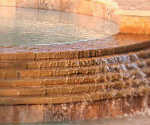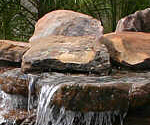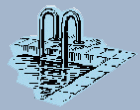Website Design by Renix Electronics, Inc.
Signature Spas

Rock Waterfalls

Water Features

![]()
![]()
![]()
Balancing Pool Water Chemicals
It is easier and less expensive to maintain clear pool water than to rectify a problem. Maintaining the correct chemical balance is important in keeping operation costs low. A properly balanced pool "uses" less chemicals.
The life of your Pool Plaster can also be affected if the amount and balance of chemicals are incorrect. See also Pool Plaster....
For example, having too little stabilizer in the water, allows the sun to destroy the chlorine in the water. Alternative, using too much stabilizer, will prevent the Chlorine from sanitizing the water. I.E. Doing it's work. Think of stabilizer as "sun block" for chlorine.
Following is a table showing the suggested numbers for some of the tests.
Water Chemistry Reference Chart
Chemical |
MIN |
IDEAL |
MAX |
| Chlorine Cyanuric Acid pH Alkalinity Hardness Iron/Copper |
1.0 ppm 20 ppm 7.2 70 ppm 150 ppm 0 ppm |
2 .0 ppm 30 - 80 ppm 7.4 - 7.6 80 - 140 ppm 200 - 450 ppm 0 ppm |
3.0 ppm 100 ppm 7.8 150 ppm 500 ppm 0.1 ppm |
Pool water testing tips
Understanding and maintaining the pH and Alkalinity by self-testing the water is not complicated.
Use the test kit provided by Alfresco Pools to test the sanitizer (chlorine) and pH (Muriatic or hydrochloric) Acid levels of your pool water at least once a week. You can also take a sample of your pool water to a pool supply company once a month, and they will typically test the pool water sample for free, provide you with a report of the pool water test, and recommend the chemicals needed.
- Purchase new test strips or liquid test kits at the beginning of each pool season to ensure accuracy.
- Adjust all chemical levels as necessary to maintain proper balance.
- Follow all chemical safety precautions and handling tips on the manufacturer’s label.
"Black Algae"
Black algae is one of the most difficult Algae to control and
eliminate. It appears a black discoloration or a tar-like deposit.
It is difficult to remove because the outer layer is
polymucosaccharide, which acts as a water repellent barrier and
shield the underlying algae from contact with the chemically-treated
water.
In addition to shock treatment, application of a polymer algaecide
is recommended, The pH should be lowered to around 7.2, and pool
jets directed towards the affected areas. Also, by adding a quart
algaecide, it acts as a wetting agent that will help the chemicals
penetrate through the polymucosaccharide barrier.
Too much chemicals
Other than costing you unnecessary money, too much chemicals can damage your equipment. Although the piping is corrosive resistant, the Power Element in the heater might need replacing more often. This gets corroded quicker with high amounts of chlorine, or high amounts of metal in the water.
Discoloration or staining of plaster
Over dosage on chemicals tends too hasten the process of discoloration of plaster over time. This can be slowed down by maintaining the correct Ph balance of the pool water.



